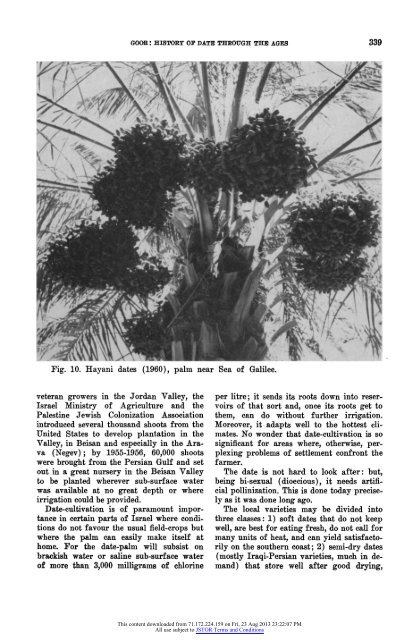The History of the Date through the Ages in the Holy Land
The History of the Date through the Ages in the Holy Land
The History of the Date through the Ages in the Holy Land
You also want an ePaper? Increase the reach of your titles
YUMPU automatically turns print PDFs into web optimized ePapers that Google loves.
GOOR: HISTORY OP DATE THROUGH THE AGES 339<br />
~~~~~~~A~~~~~1<br />
AF<br />
Fig. 10. Hayani dates (1960), palm near Sea <strong>of</strong> Galilee.<br />
veteran growers <strong>in</strong> <strong>the</strong> Jordan Valley, <strong>the</strong><br />
Israel M<strong>in</strong>istry <strong>of</strong> Agriculture and <strong>the</strong><br />
Palest<strong>in</strong>e Jewish Colonization Association<br />
<strong>in</strong>troduced several thousand shoots from <strong>the</strong><br />
United States to develop plantation <strong>in</strong> <strong>the</strong><br />
Valley, <strong>in</strong> Beisan and especially <strong>in</strong> <strong>the</strong> Arava<br />
(Negev); by 1955-1956, 60,000 shoots<br />
were brought from <strong>the</strong> Persian Gulf and set<br />
out <strong>in</strong> a great nursery <strong>in</strong> <strong>the</strong> Beisan Valley<br />
to be planted wherever sub-surface water<br />
was available at no great depth or where<br />
irrigation could be provided.<br />
<strong>Date</strong>-cultivation is <strong>of</strong> paramount importance<br />
<strong>in</strong> certa<strong>in</strong> parts <strong>of</strong> Israel where conditions<br />
do not favour <strong>the</strong> usual field-crops but<br />
where <strong>the</strong> palm can easily make itself at<br />
home. For <strong>the</strong> date-palm will subsist on<br />
brackish water or sal<strong>in</strong>e sub-surface water<br />
<strong>of</strong> more than 3,000 milligrams <strong>of</strong> chlor<strong>in</strong>e<br />
per litre; it sends its roots down <strong>in</strong>to reservoirs<br />
<strong>of</strong> that sort and, once its roots get to<br />
<strong>the</strong>m, can do without fur<strong>the</strong>r irrigation.<br />
Moreover, it adapts well to <strong>the</strong> hottest climates.<br />
No wonder that date-cultivation is so<br />
significant for areas where, o<strong>the</strong>rwise, perplex<strong>in</strong>g<br />
problems <strong>of</strong> settlement confront <strong>the</strong><br />
farmer.<br />
<strong>The</strong> date is not hard to look after: but,<br />
be<strong>in</strong>g bi-sexual (dioecious), it needs artificial<br />
poll<strong>in</strong>ization. This is done today precisely<br />
as it was done long ago.<br />
<strong>The</strong> local varieties may be divided <strong>in</strong>to<br />
three classes: 1) s<strong>of</strong>t dates that do not keep<br />
well, are best for eat<strong>in</strong>g fresh, do not call for<br />
many units <strong>of</strong> heat, and can yield satisfactorily<br />
on <strong>the</strong> sou<strong>the</strong>rn coast; 2) semi-dry dates<br />
(mostly Iraqi-Persian varieties, much <strong>in</strong> demand)<br />
that store well after good dry<strong>in</strong>g,<br />
This content downloaded from 71.172.224.159 on Fri, 23 Aug 2013 23:22:07 PM<br />
All use subject to JSTOR Terms and Conditions
















